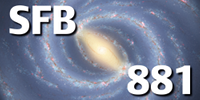→ Research in the Second
Funding Term (2015-2018)
→ Research in the Third
Funding Term (2019-2022)
Our SFB is structured around two major themes: the assembly history of the Milky Way in a cosmological context
(Research Area A), and the matter cycle and star formation on Galactic scales (Research Area
B). Research Area A studies long-term, global evolutionary processes, while Research Area B focuses on short-term,
more local processes that determine galaxy evolution.
The combined action of the more instantaneous, localized events such as star formation and feedback and the physical
processes that govern them define the present-day appearance of the luminous parts of the Milky Way and have occurred
throughout the history of our Galaxy. Their differing intensity and spatial location is determined by the long-term,
large-scale evolution of the changing amounts of baryonic and non-baryonic matter and their distribution. A comprehensive
view of the Milky Way requires knowledge and understanding of the full range of spatial and time scales from cosmological
to star formation processes and their interplay.
Research Area A is structured in seven, Research Area B in six subprojects. In addition, there are three central
infrastructure projects (Project Area Z) that are designed to benefit and support all three Research Areas. The various
subprojects are closely interconnected in a number of ways: by their science, by the common data sets from which they draw,
the common computing resources, and personnel overlap. Our proposal relies on the complementarity and the mutual benefits
of the research done in the various subprojects.
Research Area A
Research Area A focuses on how the Milky Way was assembled, drawing on extensive direct observations of its structure and
chemical composition, as well as on dynamical modeling and on simulations in a ΛCDM cosmological context.
The ΛCDM galaxy formation paradigm stipulates that the directly observable parts of galaxies like our Milky Way are
baryon concentrations at the center of a much larger dark matter halo. Such dark matter halos are predicted to form
hierarchically through gravitational instability from initial overdensities, which leads to the subsequent coalescence of
dark matter filaments and the successive merger of bound subunits. In parallel to this dark matter assembly, the baryons
cool and flow towards the centers of their dark matter (sub-)halos, where they form stars.
In disk-dominated galaxies like our Milky Way the majority of stars presumably formed from a gas disk that had settled in
the dominant dark matter halo, while others (e.g., those in the halo) presumably formed in distinct satellite galaxies that
were subsequently destroyed and incorporated. This process of dynamical assembly has been in place since high redshift and
is still ongoing. From a theoretical perspective, the Milky Way is the ideal laboratory to make and test predictions of the
ΛCDM paradigm on very small scales; from an observational perspective the "memory retention" of stars in the Milky
Way offers the unique opportunity to conduct true Galactic archaeology and to empirically investigate a galaxy's assembly
history in detail.
The proximity of the Milky Way allows us to resolve low-mass detail and to get abundances for stars along with a
3-dimensional (or 6-dimensional) view of the stellar distribution, permitting us to uncover the detailed assembly history
of a typical disk galaxy. Not only is the computational progress impressive, but also the quantity and quality of
observational information is vastly expanding.
Specifically, Research Area A comprises the following sub-projects:




